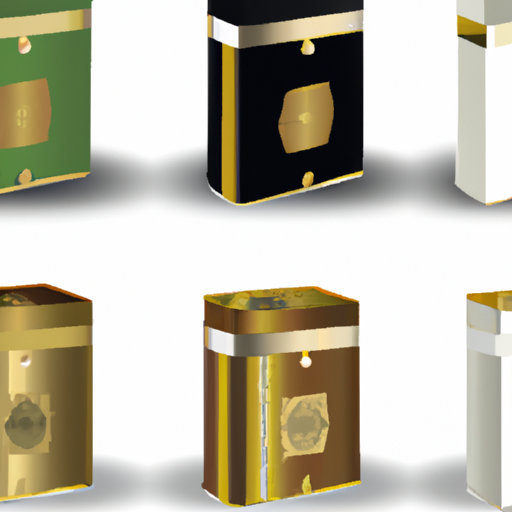A Brief History of Tea Design: From Tea Caddy to Modern Packaging
Tea is a beverage that has stood the test of time. It is more than just a drink; it is a moment to pause, to take a breath, and to find solace amidst life's chaos. To ensure that every sip is infused with the essence of history, design, and connection, it is essential to explore tea's design evolution. This is a tale of art, culture, and ingenuity, presented tantalizingly with a touch of visual delight. The journey began with the humble tea caddy, and its modern counterpart is tea packaging filled with tea leaves or tea bags. But the question remains: what inspired these design choices? Sit back, brew a fresh pot of your favorite tea, and join us in taking a sip of history!
Humble Beginnings: The Tea Caddy
A tea caddy, for the uninitiated, is a small box that holds tea leaves. The origin of the tea caddy is steeped in British history, dating back to the 18th century. Made from various materials, the purpose of a tea caddy back then was to minimize tea theft during a time when tea was an expensive luxury. Tea caddies were often adorned with intricate designs, showcasing the wealth and status of their owners.
| Period | Material | Characteristics |
|---|---|---|
| 18th Century | Wood | - Hinged lids- Locks- Barrels, apple, and pear shapes |
| 18th-19th Century | Silver | - Elegant designs- Fitted lids- Monograms and intricate patterns |
| 19th Century | Porcelain | - Imported from China and Japan- Hand-painted and gilded decorations |
Motifs and Symbolism in Tea Design
East Asian-inspired designs played a significant role in shaping the aesthetics of tea caddies and later tea packaging. Motifs were borrowed from Chinese porcelain wares, ranging from delicate floral patterns to mythical creatures. The symbolism behind these designs often reflects notions of abundance, longevity, and prosperity.
- Floral Patterns: Often used in Chinese and Japanese art to represent spiritual purity, good fortune, and joy.
- Mythical Creatures: Symbols of power, protection, wisdom, and good vibes. For instance, dragons represent wisdom and protection, while phoenixes represent rebirth and renewal.
- Landscape and Nature: Scenic landscapes and natural elements, such as mountains and rivers, are often used to evoke a sense of harmony and tranquillity to those admiring the tea design.
Transition into the 20th Century: Tea Tins and Advertising
As tea became more accessible and less expensive, the tea caddy needed to adapt. The solution was the tea tin. Made from tinplate and typically rectangle-shaped, these tea containers kept the tea fresh, while providing opportunities for creative branding through advertisements. The early 1900s saw a shift from traditional designs on containers to bold, modern designs inspired by Art Deco, Art Nouveau, and other aesthetic movements of the time. Tea brands sought to establish a unique identity with distinct logos and colors, as well as memorable slogans.
A Modern Twist: Tea Bag Packaging
As tea culture evolved, so did the methods of tea packaging. Tea bags, invented in the early 20th century, were initially embraced because they provided an affordable, easy-to-use alternative to loose leaf tea.
Now, the modern tea bag embraces sustainability and design innovation. The potential for unique packaging designs allows for a visual and tactile experience:
- Standing Pouches: Provides an upright display on store shelves and includes resealable closures.
- Tea Chests: Wooden or cardboard boxes showcasing various types of tea, often with drawers or compartments for easy organization.
- Pyramid Bags: A unique bag shape that allows for better water flow and more breathing room for the tea leaves.
A Tea-Splosion of Colors, Typography & Illustrations
Tea packaging design in the 21st century is no longer merely a vessel to hold tea leaves. It is an opportunity to create a visual identity that communicates the brand's story and values. Design elements play a crucial role in evoking the extraordinary depths of flavor and aroma within each cup.
| Design Element | Purpose |
|---|---|
| Colors | Creates a mood that correlates with the tea's character. Warm colors, like orange and red, evoke a feel of comfort and energy, while cool colors, like blue and green, convey tranquillity and freshness. |
| Typography | Communicates the brand's identity and values. Serifs and scripts may evoke tradition, elegance, and sophistication, while sans-serif and bold typefaces exude modernity, simplicity, and strength. |
| Illustrations and Patterns | Connect the consumer with the tea’s origin, story, and ingredients. Intricate illustrations of landscapes, botanicals, and cultural symbols enrich the tea experience with a sense of place and authenticity. |
In conclusion, tea design has come a long way from the simple wooden tea caddy. Today's tea packaging landscape is a diverse, exciting fusion of history, art, and modernity. However, one thing remains unchanged—the importance of retaining that sense of connection to the leaf's comforting embrace. So go ahead, grab a pack or two, and let the visual feast begin! While you're at it, share your favorite tea packaging designs in the discussion area below. We'd love to hear what fuels your enchantment with this timeless brew.
